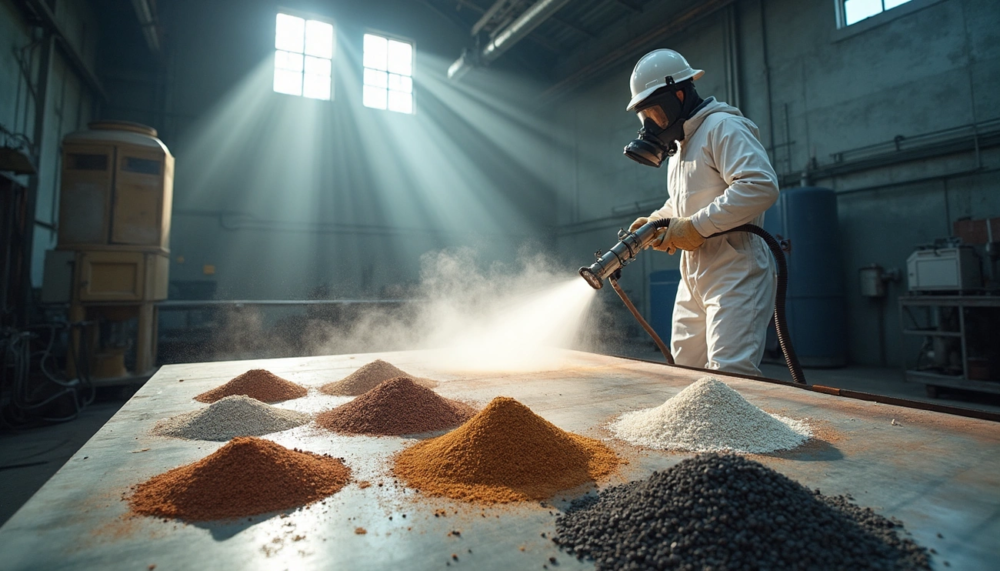
Benjamin Chew Tilghman patented surface treatment technique called sandblasting on October 18, 1870. This revolutionary process has transformed industrial cleaning and surface treatment for more than a hundred years. The technique propels abrasive materials at high pressure against surfaces to clean, shape, or add texture to them.
Sandblasting creates smoother surfaces with fewer imperfections by using materials with abrasive properties. The pressure settings typically range from 50 to 130 pounds per square inch (PSI). Modern professionals avoid using actual sand because of its health risks. They prefer safer alternatives such as steel grit, glass beads, and aluminum oxide. The process effectively removes paint, rust, and oxidation residue from various materials. Sandblasting’s versatility makes it valuable in numerous industries. Companies use it to create three-dimensional signage, clean boat hulls, treat brick and concrete surfaces, remove scratches, etch designs, and prepare surfaces for paint application.
Types of Sandblasting Techniques Explained
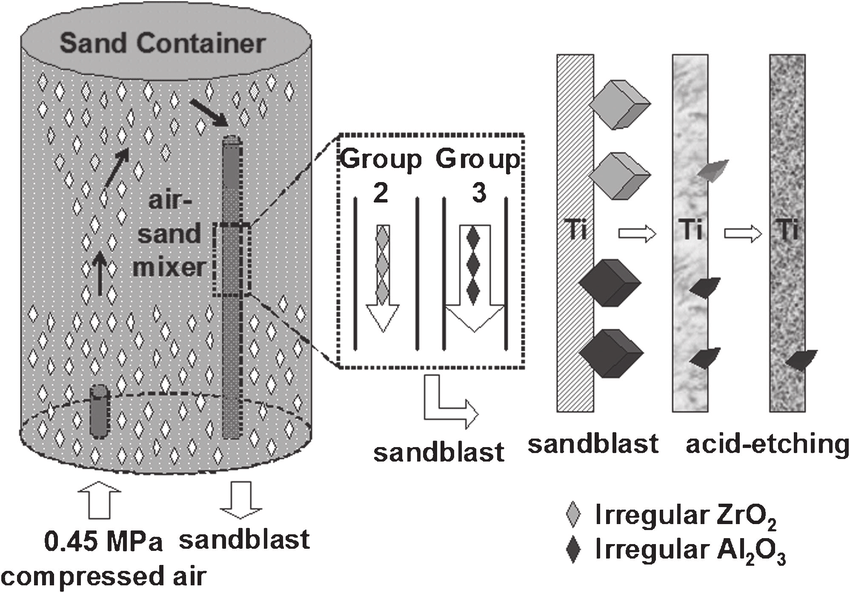
Abrasive blasting covers many techniques beyond traditional sandblasting. These variations give specialized solutions for different industrial surface treatment needs.
Sandblasting vs Shot Blasting: Key Differences
The main difference between sandblasting and shot blasting lies in how they work. Sandblasting pushes abrasive media against surfaces with compressed air. Shot blasting uses centrifugal force from mechanical wheels [1]. Shot blasting gives a more aggressive treatment that works well for larger, tougher materials like steel hulls. Sandblasting provides a gentler, more forgiving process. Sand has been replaced with safer options because silica sand creates dangerous dust that leads to silicosis. Shot blasting creates a textured surface that helps coating stick better, making it the top choice for industrial jobs needing rougher finishes.
Wet Abrasive Blasting for Dust Control
Engineers created wet blasting to solve dust-related health issues. This method puts water into the nozzle near where the abrasive comes out or mixes water with the abrasive first. OSHA’s final Silica Rule in 2016 made wet blasting methods mandatory where possible to cut down silica dust exposure. New systems like vapor abrasive blasting can reduce dust by up to 92% compared to dry blasting. Wet blasting also stops heat from building up on surfaces, which helps avoid warping thin metals or cracking weak materials.
Vapor Blasting for Delicate Surfaces
Vapor blasting mixes water, compressed air, and abrasives to clean and restore surfaces without damage. Water acts as a cushion for the abrasive on impact, making it perfect for delicate parts. This gentle process washes away dirt while protecting the material underneath. The water keeps surfaces cool during work, which prevents heat damage common in dry blasting.
Bead Blasting for Surface Finishing
Bead blasting shoots round glass beads at high speed toward work surfaces. The beads’ round shape makes small dimples that scatter light, creating a bright, uniform, satin-like look. These glass beads come from lead-free, soda-lime glass that’s safe for the environment and doesn’t react chemically. Glass bead media can be used up to 30 times with proper care, making it budget-friendly. This method works great to get smooth, polished finishes without changing the material’s base color.
Dry-Ice and Bristle Blasting Alternatives
Dry-ice blasting uses carbon dioxide pellets frozen at very low temperatures. These pellets create thermal shock and turn into gas when they hit, leaving no waste behind. The method needs expensive storage equipment to keep temperatures below -78.5°C. Bristle blasting offers another option by using rotating steel wire bristles directly on surfaces, which removes the need for projected abrasives.
Micro-Abrasive and Vacuum Blasting Use Cases
Micro-abrasive blasting uses fine nozzles (0.25mm-1.25mm) to send precise streams of abrasive to small parts of larger materials. This technique works great for tiny areas as small as 1.3mm × 2.0mm. Vacuum blasting catches abrasive media and particles right where they hit, making it perfect for tight spaces and dangerous materials like lead-based paint. The system saves and filters the blasting media for reuse and cuts down cleanup time by a lot.
Industrial Sandblasting Equipment Breakdown
、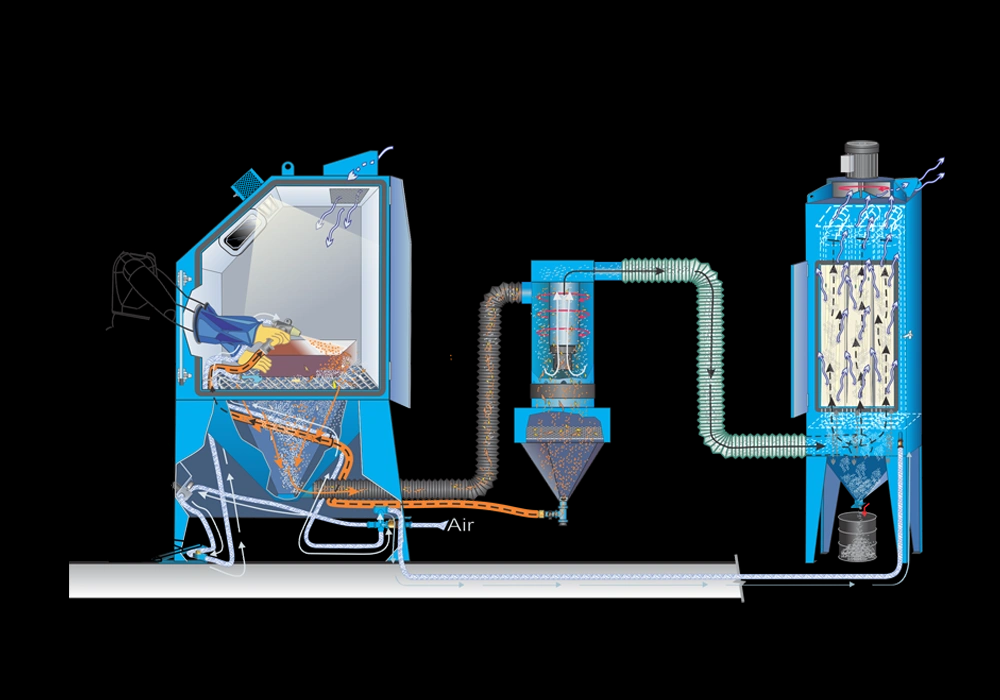
Sandblasting works best when specialized equipment matches each application perfectly. The right system choice can optimize project costs and deliver better results.
Blast Cabinet vs Blast Room: Use Case Comparison
Blast cabinets and rooms serve different scales of operation. Operators can work with cabinets from outside using attached gloves and foot pedals – perfect for smaller components. Rooms require operators to enter with full protective gear. Cabinets fit almost anywhere, but rooms need strong foundations at least 6 inches thick to handle weights up to 10 tons. The cost difference is substantial – cabinets cost between $35,000 to $55,000, while rooms range from $90,000 to $200,000 or more. Multiple cabinets often make more sense than a single room for businesses that process various small parts with different media types.
Portable Blast Equipment: Air Compressor Requirements
Air compressors are vital to any blasting system and must match nozzle specifications exactly. A 1/4″ nozzle needs at least 81 CFM at 100 PSI, plus about 20 CFM for the operator’s air-fed helmet. Larger nozzles need more air – a 1/2″ nozzle needs 338 CFM at the same pressure. Hose length changes performance, with pressure dropping about 0.07 bar every 50 feet. Clean, dry air is vital – moisture can cause maintenance problems and unwanted downtime.
Blast Pot and Nozzle Configuration
The right blast pot setup starts by connecting the air compressor to the bull hose with safety restraints like whip checks and pins. Air flows through a prep unit that removes moisture before reaching the pressurized pot. Venturi nozzles boost production rates up to 40% better than straight bore options. Nozzle size shapes both the blast pattern and efficiency. Common sizes start at 1/4″ and go up to 5/8″, increasing by 1/16″ steps. Regular nozzle wear checks are important since enlarged openings need more air volume to keep the target pressure.
Wet Blast Equipment and Cryogenic Deflashing Systems
Systems like the Wetblast FLEX let operators switch between wet and dry applications with simple fingertip controls. These systems add water at the pot base or nozzle to reduce dust while keeping blast effectiveness. Cryogenic deflashing offers another approach by using liquid nitrogen to make the flash brittle. This allows quick removal through tumbling with polycarbonate media. The process takes minutes instead of hours and preserves critical tolerances. It works well with plastics, polymers, rubber, and silicone. Virgin polymer media gives better results than reprocessed materials for manufacturers who want consistent quality.
Abrasive Media Types and Their Applications
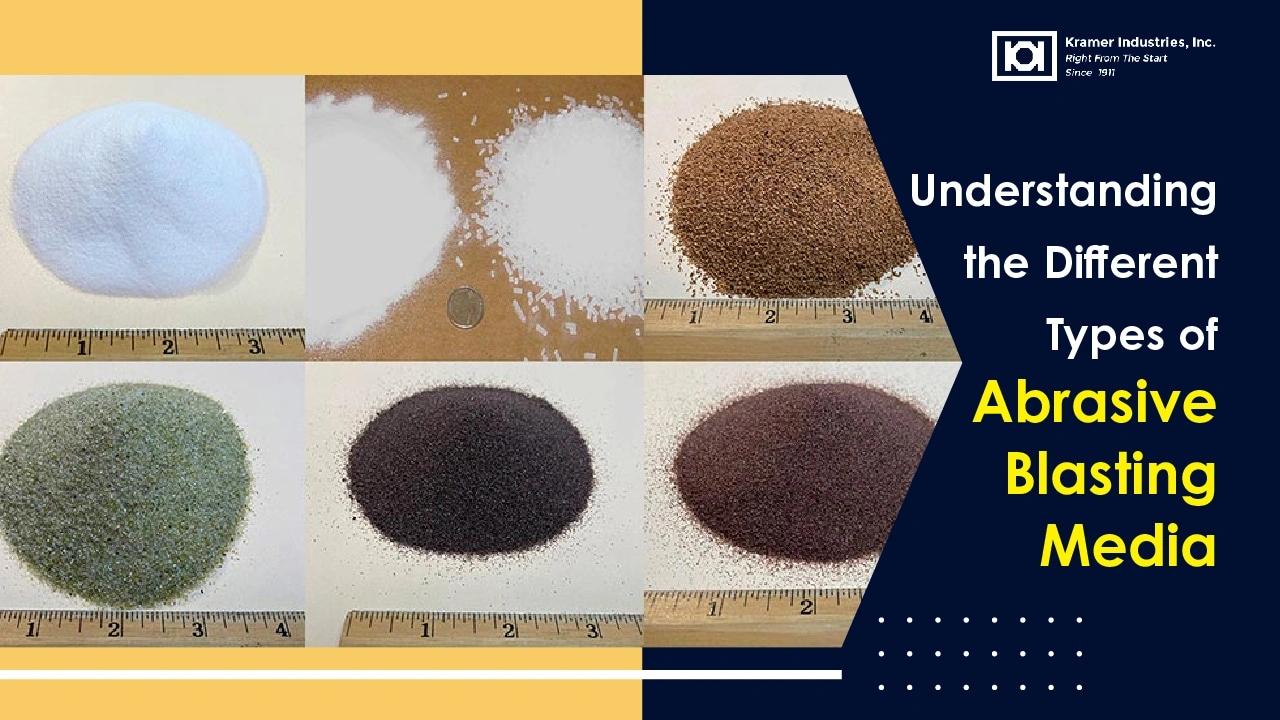
The right abrasive media plays a vital role in getting the best sandblasting results in a variety of applications. Different media types have unique properties that change how sandblasting affects each surface.
Aluminum Oxide Grit for Surface Preparation
Aluminum oxide scores between 8 and 9 on the Mohs hardness scale. This makes it incredibly tough for surface preparation. The angular abrasive delivers precise and consistent results because manufacturers can screen it to exact grit sizes instead of ranges. Its high purity rating (90%+) lets you recycle it almost endlessly, which saves money and helps the environment. You’ll find aluminum oxide works best on ferrous metals, stainless steel, stone, and glass when you need scale removal, deep etching, or anchor profiles.
Soda Blasting for Rust Removal
Sodium bicarbonate (baking soda) gives you a gentle but powerful blasting option with a Mohs hardness of just 2.4. This media removes contaminants without hurting the surface underneath. The natural rust-inhibiting properties of soda blasting leave a protective layer that stops flash rusting. This gives it an edge over sandblasting, which needs immediate painting. You can use it for everything from removing graffiti to cleaning food processing equipment.
Steel Grit and Shot for Heavy-Duty Cleaning
Steel grit and shot serve different purposes based on their shapes. The angular particles of steel grit create an etched surface that coatings stick to better. Steel shot’s round shape creates a dimpled, peened finish that works better for polishing. Both types last long and can be recycled many times. Steel shot excels at peening jobs like making gear parts and springs. Steel grit does its best work removing mill scale and creating blast profiles.
Crushed Glass and Staurolite for Eco-Friendly Blasting
Manufacturers make crushed glass from 100% recycled bottle glass. This gives you an eco-friendly option without free silica or heavy metals. Its angular and sub-angular structure cuts aggressively while protecting surfaces. Staurolite offers moderate cutting speed and creates less dust, which makes it perfect for delicate surfaces.
Organic Media: Walnut Shells and Corn Cobs
Organic abrasives give you gentler options for sensitive surfaces. Walnut shells have an angular profile and a hardness of 4.5-5 on the Mohs scale. You can use these in both wet and dry applications to achieve near-mirror finishes. Corn cob media (4.5 Mohs) stands out at cleaning wood surfaces without causing damage. These organic options break down naturally and protect the environment, which makes them perfect when you need to preserve the surface underneath.
Health, Safety, and Environmental Considerations
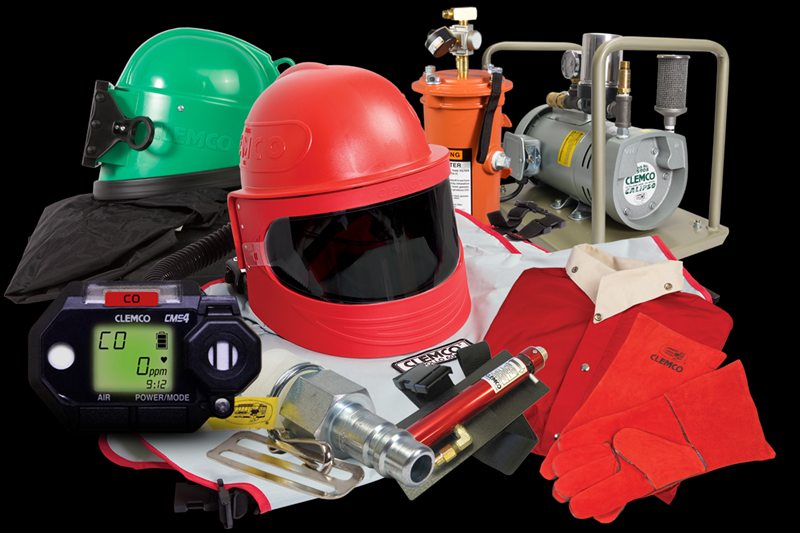
Sandblasting operations create serious workplace hazards that need strict safety protocols. Workers face multiple risks during industrial sandblasting. These risks need proper management to keep everyone safe.
Silica Dust Exposure and Silicosis Risk
The industry has mostly stopped using silica sand in sandblasting because it’s too dangerous for health. Workers who breathe in crystalline silica dust can develop silicosis, which damages their lungs and can be fatal. NIOSH recommended a complete ban on silica sand as a blasting material back in 1974. The dust creates fibrotic nodules and scars in lung tissue. Workers exposed to fine silica particles have a higher chance of getting tuberculosis. OSHA’s current limit allows 100 μg/m³ of respirable crystalline silica over an 8-hour average.
NIOSH and OSHA Guidelines for PPE
OSHA demands complete controls to stop airborne contaminant exposure. Workers must use NIOSH-certified respiratory protection when engineering controls can’t keep exposure below limits. Operators need NIOSH-certified Type CE abrasive blasting respirators in enclosed spaces or when using materials with more than 1% crystalline silica. The basic PPE needed:
- Airline positive pressure hood or helmet
- Protective suits to keep out dust and abrasive grit
- Chemically resistant gloves and safety boots
- Appropriate hearing protection
Blast Hood and Grade-D Air Supply Requirements
Blasting helmets need Grade D breathing air. The oxygen content should stay between 19.5% and 23.5%, with carbon monoxide under 10 ppm, carbon dioxide below 1,000 ppm, and hydrocarbon content less than 5 mg/m³. Oil-lubricated compressors need high-temperature or carbon monoxide alarms to prevent poisoning. Breathing air compressors should stay away from exhaust gasses and other contaminants.
Noise and Heat Hazards in Enclosed Systems
The noise from abrasive blasting can reach 120 dBA. OSHA standard 1910.95 limits unprotected operators to just 15 minutes of blasting daily. Enclosed blasting areas need proper ventilation to prevent heat stress. Long exposure to noise can permanently damage hearing and cause tinnitus among other hearing problems. Yes, it is crucial for employers to run a hearing conservation program that monitors, tests, and protects workers.
Conclusion
Sandblasting technology has changed by a lot since Benjamin Chew Tilghman patented it in 1870. The industry moved away from silica sand to safer abrasive options like aluminum oxide, steel shot, glass beads, and organic media. This change shows the industry’s steadfast dedication to both performance and worker safety.
Today’s professionals have more blasting options than ever before. Wet blasting cuts dust exposure by 92%, while vapor blasting protects delicate surfaces through water-cushioned abrasive effect. Specialized methods like micro-abrasive and vacuum blasting let workers handle precise work on small areas or hazardous materials. The key is picking the right method based on project needs rather than using one approach for everything.
The right equipment makes a big difference in sandblasting success. Blast cabinets work well for smaller parts, and blast rooms handle bigger industrial jobs. Without doubt, proper air compressor sizing is crucial – low CFM rates or pressure levels hurt efficiency and can damage surfaces. The best results come from matching the blast pot, nozzle setup, and abrasive media to the job.
Safety must come first in all sandblasting work. OSHA and NIOSH rules spell out clear steps for breathing protection, especially Grade D air requirements. Workers need hearing protection, too, since noise levels often go past 120 dBA. Companies that put safety first don’t just protect their teams from silicosis and other risks. They get better results because their workers are well-trained and properly equipped. Sandblasting remains a vital industrial process that balances new technology with worker health.
FAQs
Q1. What is sandblasting and how does it work? Sandblasting is an industrial surface treatment technique that propels abrasive materials at high pressure against surfaces to clean, shape, or texture them. It uses compressed air to force abrasive media through a nozzle, effectively removing paint, rust, and other contaminants from various materials.
Q2. What are the different types of sandblasting techniques? There are several sandblasting techniques, including wet abrasive blasting for dust control, vapor blasting for delicate surfaces, bead blasting for surface finishing, and dry-ice blasting as an eco-friendly alternative. Each technique has specific applications and benefits depending on the surface being treated.
Q3. What types of abrasive media are used in sandblasting? Common abrasive media used in sandblasting include aluminum oxide grit, steel grit and shot, crushed glass, and organic materials like walnut shells and corn cobs. The choice of media depends on the surface being treated and the desired finish.
Q4. What safety precautions are necessary when sandblasting? Safety is crucial in sandblasting operations. Workers must wear appropriate personal protective equipment (PPE), including respirators, protective suits, gloves, and hearing protection. Proper ventilation and air supply systems are also essential to prevent exposure to harmful dust and ensure safe breathing conditions.
Q5. What industries commonly use sandblasting? Sandblasting is widely used across various industries, including automotive, marine and shipbuilding, aerospace, construction, manufacturing, oil and gas, and military and defense. It’s employed for tasks such as surface preparation, rust removal, paint stripping, and creating textured finishes on different materials.
